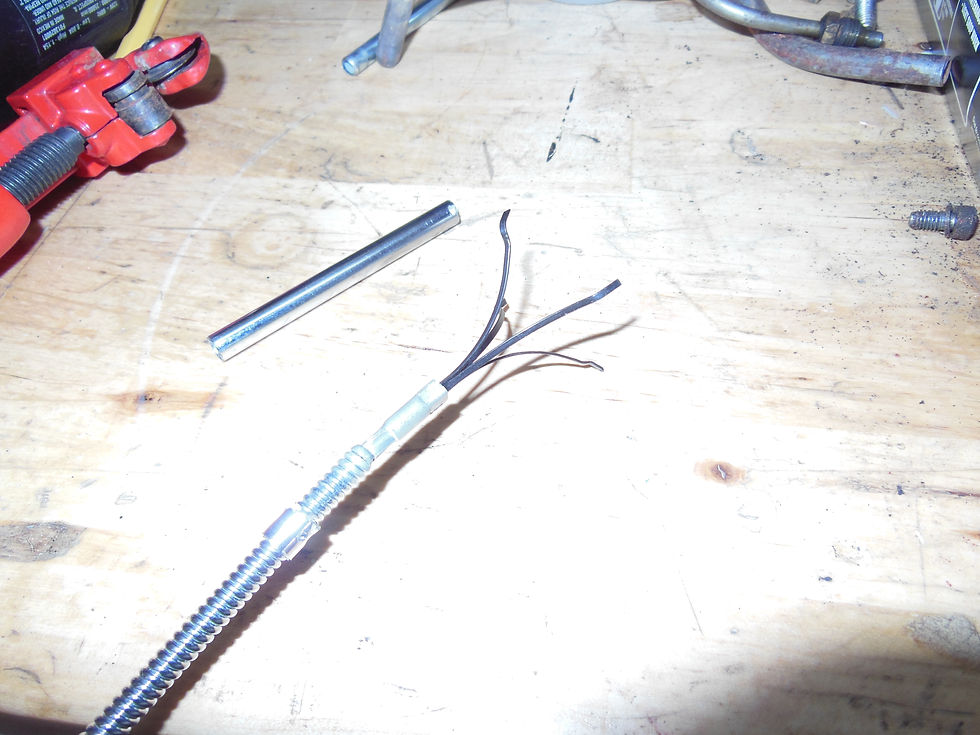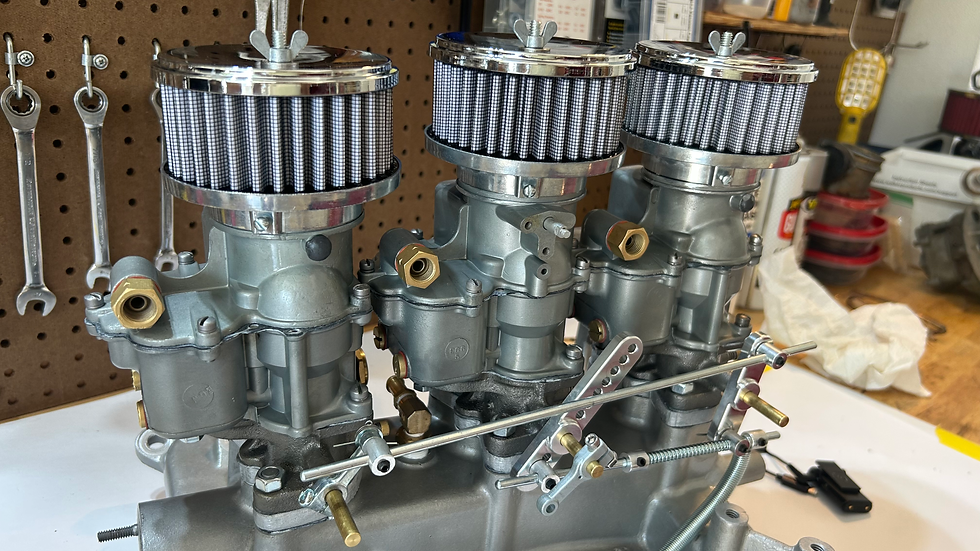1955 Ford Part 78: The Switch from Edelbrock to Holley
- Hot Rod Reverend
- Jun 5, 2019
- 5 min read
Updated: Dec 27, 2019
The Switch from Edelbrock to Holley

Continuing from blog post #77, the effort to find a suitable carburetor for the 292 Ford Y block has finally come about to a major change. Yes, you can see from the title photo that the Edelbrock was removed (and promptly sold) and a re-manufactured Holley 1850 4 barrel was installed. This carburetor has vacuum secondaries as well, but flows 600 cfm instead of 500 cfm. We kept the manual choke feature. The carburetor was purchased through eBay by a small company in California that re-manufactures a number of carburetors and provides a 1 year warranty on each carb.




The shipping of the carb certainly looked professional, complete with vacuum packed, molded filler to protect the Holley 1850 in the box. However, the carburetor was not shrink-wrapped (something I do with the carbs I sell just as an extra measure to keep debris from entering any orifice or passageway).


Once I removed the 4 barrel from the box it was easy to see that the carb was immaculate concerning cleanliness and there was nothing "sloppy" in linkage or what have you. It appeared to be about as new as you could get.
And another video showing some details of the temporary plumbing...
Even for the most novice of wrench-turners it would be pretty basic to understand that when switching from one brand of aftermarket carburetor to the next that the plumbing will be different. Even the linkage is different in this case. Whereas the Edelbrock has a fuel entry port on the rear passenger side of the carb body, the Holley places its fuel entry port on the driver's side and up front. (Is this because of the difference between Ford and GM and where their mechanical fuel pumps sit on a majority of their 50s/60s engines?) Everything was different except for the fact that the carburetors bolted to the same intake manifold. Therefore, a new linkage rod had to be fabricated, the PCV run differently, the vacuum ports were different, etc. The real kicker was the choke linkage. The choke mechanism ended up being too far forward for the 1955 manual choke cable to reach. What to do?
I decided to extend the reach of the cable with... more cable. A cheap lawn mower cable throttle control was purchased and away we went.

The metal, spiral sheathing was the same outside diameter as the 55 Ford sheathing. I cut the end off (a little more than I needed) so that I could take both the line and the sheathing for an extension. Next up was to cut the metal tube off of one of those cheap "grabbing" tools that I picked up at a swap meet recently.


Hang with me, I am taking us somewhere. =)
Once I had the hollow tube, it was time to place a 3/4" length of sheathing inside one of the ends and crimp the tube around the sheathing. I was careful to make sure that the sheathing would not move but that the line could slide inside easily.

Then the other end of the tube was crimped to the 55 Ford choke cable sheathing and it was actually the tube that was mounted to the carb. The parts fit together well on the carburetor, and only the well-trained eye would be able to tell that I modified the original cable this way... especially with an air cleaner in place.

With the exception of a barrel stop, the installation appears very clean. Speaking of barrel stops, it was quite irritating that no hardware or auto parts store near me had one available for sale. I think Menards did have one in stock, but the store is about 20 minutes away from where I live. When I asked employees at Lowe's, Home Depot, or even Tractor Supply Company, they acted like they had never heard of a barrel stop.
Speaking of hardware and the like, consider these expensive gems:

In my quest to finish off the plumbing for the fuel line, the search for fittings at local auto parts and hardware stores was fruitless and an all-out waste of time. I visited everything within a 10 mile radius of where I live: Tractor Supply Company, O'Reily's, Autozone, Advance Auto, Lowe's, Home Depot, etc. While the hardware stores had a good selection of NPT fittings, trying to find adapters that will hook a flare end to an NPT end is just crazy stuff. I had to order most of the fittings in the picture, save one. You may recognize the banjo fitting - that was purchased for the inlet port of the Holley. I ended up running a small length of line from the Holley regulator to the inlet port of the carburetor. Do not even ask what these brass fittings cost. I am embarrassed to admit that I have $23 in the above pieces alone!
The last part of this blog entry concerns a very controversial piece on fuel filter history...

Yes, friends and neighbors, enter the serviceable glass filter that puts fear in the hearts of most gear heads! These are prone to leak and start fires, there is no debate about that. So why would the Hot Rod Reverend install one of these filters that would be sure to engulf his beloved Ford in a fury of uncontrollable flames? Now, before anyone begins sending hateful email's and messages to my inbox, all should rest assured in knowing that I have a Wix 33032 on the way to be installed.
The first reason for tempting fate: to easily check the pumping of fuel up to the carburetor when the engine is hot and at idle. I have had my reservations about ethanol fuel and its "boiling point" properties. We already know that today's gasoline blends at the pump don't play nice with classic car parts such as period gas tanks, lines, carburetors, etc because of the corrosive properties and because of ethanol's wonderful ability to attract moisture, drawing it into the fuel system. These problems can be offset with fuel stabilizer or other additive, but I have yet to find anything that will raise the boiling point of gasoline blended with ethanol.
You can see the filter empty in the photo. Just after a 20-25 minute run in the Ford, I came back into the garage and let the car idle with the hood raised. There was barely any fuel pumping into the filter as the car sat and just ran for a few minutes. There were plenty of bubbles and sloshing around in the filter. Mind you, when the car is cold, or otherwise not at operating temperature, the filter remains close to full or at least 3/4 full, and the fuel has no bubbles at all, no sloshing around, etc. (even after a 10 minute run or so) This photo above was taken just after shut down. It was very hot to the touch, even though it was far enough way from the block, exhaust manifolds, etc, and even though there was a good length of fuel injection hose above and beneath.
What's going on? Quite simply, the fuel is basically "cooking" as it is pumped through a hot fuel pump. All of this and the car idles at only 180 degrees on an 85 degree day, checked with my Autometer gauge and an infrared thermometer.
What is the solution? I could try to find an additive that can significantly raise the boiling point of the modern blends of gasoline and ethanol (sounds like a good science project for my son this year in his Chemistry class!) or purchase ethanol-free gasoline. We will continue to look for #1, but I did locate an ethanol free gasoline station about 25 minutes away. And, I purchased three 5 gallon Jerry cans so we can be prepared to fight the issues with modern fuel (solution #2). As we drive the car more, especially in hot weather, the problems with ethanol and heat soak will have to be put to rest.
the Hot Rod Reverend




Comments